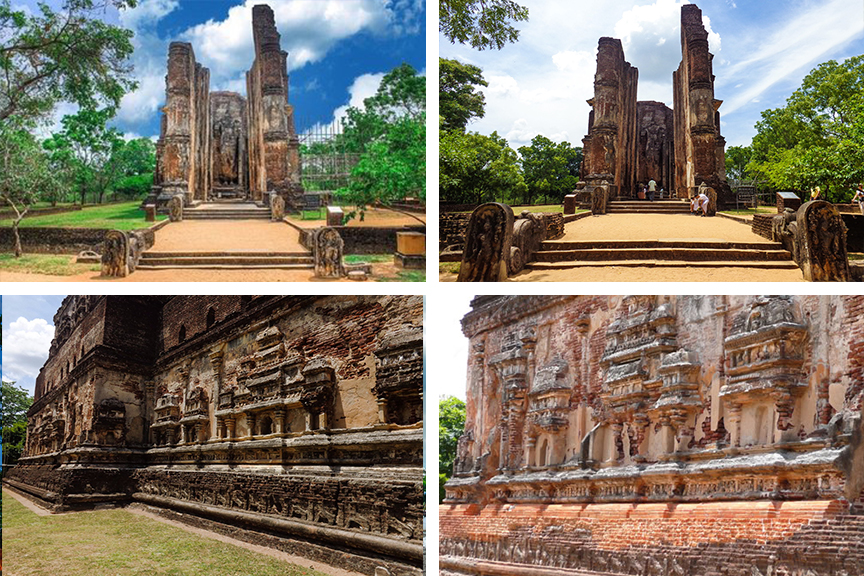The Ancient City Polonnaruwa
About Polonnaruwa,
Polonnaruwa is the main town of Polonnaruwa District in North Central Province, Sri Lanka. Kaduruwela area is the Polonnaruwa New Town and the other part of Polonnaruwa remains as the royal ancient city of the Kingdom of Polonnaruwa. The second most ancient of Sri Lanka's kingdoms, Polonnaruwa was first declared the capital city by King Vijayabahu I, who defeated Chola invaders in 1070 to reunite the country once more under a local leader. The Ancient City of Polonnaruwa has been declared a World Heritage Site. Currently the new Polonnaruwa is under going a major development project known as the "Awakening of Polonnaruwa" under the concept of President Maithripala Sirisena. It envisions the development of all sectors in Polonnaruwa including roads, electricity, agriculture, education, health and environment will be developed comprehensively
Places to visit in Polonnaruwa
Polonnaruwa Museum
The Quadrangle

At the heart of the ancient city, the Dalada Maluwa (Terrace of the Tooth Relic), popularly known as the Quadrangle, was the centrepiece and sacred precinct of ancient Polonnaruwa, home to the Tooth Relic and its most important cluster of religious shrines. The Quadrangle is dominated by the flamboyant Vatadage, a superbly decorated circular shrine and perhaps the most ornate building in Sri Lanka: its outer walls are carved with friezes of lions, dwarfs and lotuses, and, at each of the four entrances, with elaborate moonstones and guardstones (depicting nagaraja – king cobra figures with seven-hooded heads).
The Lankatilaka

The impressive walls of the Lankatilaka image house soar to a height of 16 metres (55ft), enclosing a large but headless statue of the Buddha who stands squashed inside the high, narrow space within. A section of the walls outside is adorned with finely carved reliefs of flamboyant multi-storey houses topped with domes – not a portrait of ancient Polonnaruwa as is sometimes claimed, but a fanciful representation of the celestial abodes (vimanas) of the gods.
Gal Vihara
 The pinnacle of rock-carved art in ancient Sri Lanka, the Gal Vihara is home to four magnificent Buddha statues hewn out of a granite cliff-face by unknown artists. The highlight is the majestic 14-metre (46ft) reclining Buddha – a figure of such enormous but serene beauty that it inspired centuries of Sinhalese art without ever being matched. The sculptor was working in a medium that to some extent dictated his output. Dark strata in the rock appear as a veil of ripples washing over the delicately carved facial features and figure of the Buddha as he slips into nirvana, lending a beautifully fluid texture to the mass of stone.
The pinnacle of rock-carved art in ancient Sri Lanka, the Gal Vihara is home to four magnificent Buddha statues hewn out of a granite cliff-face by unknown artists. The highlight is the majestic 14-metre (46ft) reclining Buddha – a figure of such enormous but serene beauty that it inspired centuries of Sinhalese art without ever being matched. The sculptor was working in a medium that to some extent dictated his output. Dark strata in the rock appear as a veil of ripples washing over the delicately carved facial features and figure of the Buddha as he slips into nirvana, lending a beautifully fluid texture to the mass of stone.Minneriya and Kaudulla national parks
The area around Polonnaruwa is one of the best in which to spot Sri Lanka’s legendary elephants, with Minneriya and Kaudulla national parks being the places to head for. Both parks are centred on extensive tanks where elephants congregate in increasingly large numbers towards the end of the dry season, particularly during the famous “Gathering” at Minneriya National Park. The two parks are linked by an important “elephant corridor”, designed to allow the animals to move from one park to the other as the fancy takes them.
see more about Minneriya and Kaudulla national parks
Polonnaruwa, Sri Lanka’s splendid medieval capital was established as the first city of the land in the 11th Century, A.D. It replaced Anuradhapura, which was plundered, made desolate and laid hopelessly bare to the invading armies from South India.
Three Kings dominate the chronicles of the city and the period. The city reached a dazzling but pitifully brief zenith in the 12th century and though ravaged by invasion in the centuries that followed, much evidence remains of the old grandeur and glory.The ruins of the ancient city stand on the east shore of a large artificial lake, the Topa Wewa Lake, or Parakrama Samudraya (the Sea of Parakrama), built by King Parakramabahu I (1153-86), whose reign wasPolonnaruwa‘s golden age. Within a rectangle of city walls stand palace buildings and clusters of dozens of dagobas, temples and various other religious buildings.A scattering of other historic buildings can be found to the north of the main complex, outside the city walls and close to the main road to Habarana and Dambulla.
To see many of the relics excavated from the site such as the stone lion which once guarded the palace of King Nissanka Malla, or the fine Hindu bronzes unearthed from the ruins of the Siva Devale Temple – you may have to visit the National Museum in Colombo, where they are kept. However, with the opening of the new Polonnaruwa Visitor Information Centre and its museum in 1998/9 some of the key exhibits were scheduled to return to the place where they were discovered.
Some of the content and images contained herein are the property of their original owners.












No comments: